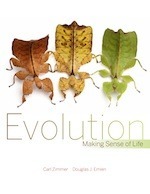Carl Zimmer's Blog, page 37
November 20, 2012
Heredity: New Radiolab Episode (Introducing Charlotte and Veronica Zimmer)
Jad Abumrad and Robert Krulwich have a new episode of Radiolab airing this week. The theme of the show is heredity and its attendant mysteries. I had great fun telling the strange and tragic story of the early twentieth century biologist Paul Kammerer, who thought he could change the human race with the help of a midwife toad. (Some of my favorite sources about this tale and its present-day reverberations are here, here, here, here, here, and here.)
Science writer Sam Kean joins the Radiolab crew as well, along with some scientists doing fascinating work on mother rats licking baby rats, Swedes surviving harsh winters, and more.
Added bonus: my daughters Charlotte and Veronica helped read the program credits. They get their ability to pronounce “Jad Abumrad” from me.
I’ve embedded the show below–

November 16, 2012
Steven Pinker’s Style Guide
Each year I run a workshop for science graduate students at Yale, encouraging them to write clearly, compellingly, and effectively. I’m tempted next year to just cue up this video of Steven Pinker discussing his next book–a psychology-based guide to good writing–and kick back.
[via]

Creeping Out the Kids: @TEDYouth tomorrow
TEDYouth is in its second year of putting together an afternoon of short talks for high school students. I’ll be joining in with a quick introduction to my favorite parasite. The event, which takes place in New York City, will be live-streamed–visit this page for more information for viewing. It will run from 1 pm to 6 pm ET. I’m scheduled to talk at 2:45.

November 15, 2012
Fear, Reward, and The Bottle: An Update to My Column on Neurogenetics
 In May I wrote in Discover about a major experiment in neuroscience. Ahmad Hariri, a neuroscientist at Duke, is gathering lots of data from hundreds of college students–everything from genetic markers to psychological profiles to fMRI scans. He hopes that the Duke Neurogenetics Study, as he’s dubbed it, will reveal some of the ways in which the variations in our genes influence our brain circuitry and, ultimately, our personality and behavior.
In May I wrote in Discover about a major experiment in neuroscience. Ahmad Hariri, a neuroscientist at Duke, is gathering lots of data from hundreds of college students–everything from genetic markers to psychological profiles to fMRI scans. He hopes that the Duke Neurogenetics Study, as he’s dubbed it, will reveal some of the ways in which the variations in our genes influence our brain circuitry and, ultimately, our personality and behavior.
Hariri plans to collect data from over 1000 people, but he and his colleagues are already starting to analyze the hundreds of students they’ve already examined to look for emerging patterns. In the open-access journal Biology of Mood and Anxiety Disorders, they’ve just published some of their first results. While the results are, of course, preliminary, they do offer an interesting look at the future of neuroscience. Rather than pointing to some particular gene or brain region to explain some feature of human behavior, neuroscientists are learning how to find patterns that emerge from several factors working together.
For their new study, Hariri and his colleagues looked in particular at problem drinking. They hoped to find factors that ...

November 14, 2012
Excuse The Hoot!
 The American Association for the Advancement of Science has just announced this year’s Kavli Awards for Science Journalism. I’m pleased to report that I won in the category of newspapers with a circulation of 100,000 or more.
The American Association for the Advancement of Science has just announced this year’s Kavli Awards for Science Journalism. I’m pleased to report that I won in the category of newspapers with a circulation of 100,000 or more.
The award was for three stories I wrote for The New York Times. They didn’t have much in common, which is how I like it:
A Sharp Rise in Retractions Prompts Calls for Reform (April 17)–The scientific enterprise is getting dysfunctional. The fact that this article received 341 comments suggests to me that it hit a nerve.
Studies of Microbiome Yield New Insights (June 19)–I explore the emerging concept of medical ecology, in which we look at our bodies as wildlife parks to be managed, rather than battlegrounds to be carpet-bombed.
Evolution Right Under Our Noses (July 26)–My editor at the time, James Gorman, came across a cool paper on the rapid evolution of fish in the Hudson River. I said, “It’s nice, but it’s not unique by any means. I mean, evolution’s going on all over New York.” Gorman, with that sharp editorial nose of his, said, “Really? Then right about that.” So off I went to ...

November 11, 2012
Herman Melville, Science Writer
Over the past few weeks, I’ve been dipping into a project called “Moby Dick Big Read.” Plymouth University in England is posting a reading of Moby Dick, one chapter a day. The readers are a mix of writers, artists, and actors, including Tilda Swinton. They are also posting the chapters on SoundCloud, which makes them very easy to embed. Here is one of my personal favorites, Chapter 32, “Cetology.”
When I was an English major in college, I read Moby Dick under the guidance of English professors and literary critics. They only paid attention to a fraction of the book–the fraction that followed Ishmael on his adventures with Captain Ahab. This was the part of the book that they could easily compare to other great novels, the part they could use for their vague critiques of imperialism, the part–in other words–that you could read without having to bother much with learning about the particulars of the world beyond people: about ships, about oceans, and, most of all, about whales. How many teachers, assigning Moby Dick to their students, have told them on the sly that they could skip over great slabs of the book? How many students have missed ...

November 7, 2012
On the Occasion of My Belly Button Entering the Scientific Literature
Our skin is encased in a snug microbial suit, from our scalps to the tips of our toes. Bacteria begin to colonize our skin from the moment we are born, and they continue to coat us throughout life. They do us many favors. They moisturize our skin to keep it supple; they unleash anti-microbial toxins to ward off pathogens that might make us ill. Scientists know that our skin is home to many species, but they can’t yet say exactly how many–or why some species are found more often on the elbow than on the chin.
Two years ago at a conference in North Carolina, I ran into Rob Dunn, a biologist who was conducting a survey of this menagerie. He was interested in the life found in one particular spot on the human body: the belly button. At the conference, he was handing out Q-tips people could use to swab their navels, which he and his colleagues could then study to tally up the species dwelling there.
Five months later, Dunn sent me a preliminary report: “You, my friend, are a wonderland.” I was the proud host of 53 different types of bacteria, including some decidedly weird creatures, such as ...

October 31, 2012
Evolution Textbook: The App Grows!

Evolution: Making Sense of Life, the textbook Doug Emlen and I have just published, is now evolving into a full-blown app for the iPad. Once you get the free app, you can download some of the book’s chapters. We’ve now got the first eight chapters in the iTunes store. Chapters 1 (the introduction) and Chapter 8 (natural selection in the wild) are available for free. Chapters 2-7 can be purchased individually for between $4.99 and $9.99. The full book will be available December 1st, 2012; all 18 chapters will be priced at $80.

October 29, 2012
In praise of the big old mess
In June, a writer named Jonah Lehrer got busted for recycling material on a blog at the New Yorker. Lehrer, who specialized in writing about the brain, had been writing a blog called The Frontal Cortex for six years at that point; having just been appointed a staff writer at the New Yorker, he moved it to their web site, where he promptly cut and pasted material from old posts, as well as from magazine and newspaper pieces.
At the time, I just thought he was squandering a marvelous opportunity. When I was asked to comment on the situation, I wrote that some of the things Lehrer had done were uncool, while some were fairly harmless. But Lehrer himself acknowledged that what he was done was stupid, lazy, and wrong. So I figured he’d gotten the sort of school detention that wakes you up and keeps you from getting expelled.
Four months later, I’m struck by how wrong I was.
I’m quoted in the latest of a long string of articles about Lehrer’s misdeeds, a feature in this week’s issue of New York by Boris Kachka. Kachka talked to me for a long while, and it’s clear that he talked to ...
October 27, 2012
Our Viral Future: Video of My Recent Talk
I recently gave a talk in San Francisco about the future of viruses, based in part on my book, A Planet of Viruses. I talk about how deadly new outbreaks may emerge, how we may harness viruses for technology and medicine, and just how many viruses there are out there (hint: 10000000000000000000000000000000).
Author Carl Zimmer: Our Viral Future from Singularity Institute on FORA.tv






















